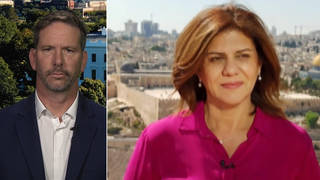
Topics
Guests
- Esther Schorprofessor of English and acting chair of the Humanities Council at Princeton University.
Opposition is growing to the Trump administration’s new proposal to implement radical changes to U.S. immigration law and slash the number of immigrants allowed into the United States by half. The RAISE Act would create a so-called merit-based immigration system that would favor applicants who speak English, have advanced degrees or can demonstrate job skills. On Wednesday, CNN’s Jim Acosta pressed senior policy adviser Stephen Miller over President Trump’s push to admit only English-speaking immigrants in a back-and-forth that lasted for several minutes. Acosta asked Miller about the iconic poem “The New Colossus” by Emma Lazarus that is inscribed at the base of the State of Liberty, which reads: “Give me your tired, your poor, your huddled masses yearning to breathe free.” We speak about the woman who wrote those words, Emma Lazarus, with her biographer, Esther Schor, about why Lazarus wrote the poem, how it became one of the most iconic verses about the United States and why she has long been a target of white nationalists.
Transcript
AMY GOODMAN: Opposition is growing to the Trump administration’s new plan to radically overhaul U.S. immigration law and slash the number of immigrants allowed into the United States by half. The RAISE Act, or Reforming American Immigration for Strong Employment, would create a so-called merit-based immigration system that would favor applicants who speak English, have advanced degrees or can demonstrate job skills.
Since President Trump and Republican senators introduced the proposal on Wednesday, many commentators have noted the proposed policy would have likely blocked Trump’s own grandfather, Friedrich Drumpf, from immigrating to the United States, had it been in place in 1885. At the time of his arrival, Drumpf did not speak English, and his immigration record says he had no identifiable skill—or “calling,” as they called it. The great-grandparents of senior policy adviser Stephen Miller would have also likely been refused entry under the proposed plan, since they spoke only Yiddish. Kellyanne Conway’s great-grandfather, too, would have likely been barred for speaking only Italian.
Well, on Wednesday, CNN’s Jim Acosta, who is the son of immigrants, pressed senior policy adviser Stephen Miller over President Trump’s push to admit English-speaking, only, immigrants in a back-and-forth that lasted for several minutes. This is an excerpt.
STEPHEN MILLER: I mean, you really don’t know that.
JIM ACOSTA: My father was a Cuban immigrant. He came to this country in 1962, right before the Cuban missile crisis, and obtained a green card. Yes, people who immigrate to this country can eventually—
STEPHEN MILLER: OK. So, Jim—
JIM ACOSTA: People who immigrate to this country through—
STEPHEN MILLER: So, Jim, as a factual question, Jim—
JIM ACOSTA: —not through Ellis Island, as your family may have—
STEPHEN MILLER: Jim, as a factual—Jim, as a factual question—
JIM ACOSTA: —but in other ways, do obtain a green card at some point. They do it through a lot of hard work. And, yes, they may learn English as a second language later on in life. But this whole—
STEPHEN MILLER: So, but, Jim—
JIM ACOSTA: This whole notion that, well, they could learn—you know, they have to learn English before they get to the United States, are we just going to bring in people from Great Britain and Australia?
STEPHEN MILLER: Jim, actually, I have to honestly say I am shocked at your statement that you think that only people from Great Britain and Australia would know English, as, actually, it reveals your cosmopolitan bias to a shocking degree, that in your mind—no, this is an amazing—this is an amazing moment. This is an amazing moment. That you think only people from Great Britain or Australia would speak English is so insulting to millions of hard-working immigrants who do speak English from all over the world.
JIM ACOSTA: My father came to this country not speaking any English.
STEPHEN MILLER: Jim, have you honestly—Jim, have you honestly never met an immigrant from another country who speaks English, outside of Great Britain and Australia? Is that your personal experience?
JIM ACOSTA: Sir, of course there are people who come to this country from other parts of the world.
STEPHEN MILLER: But that’s not what you said! And it shows—it shows your cosmopolitan bias. And I just want to say—
JIM ACOSTA: It just sounds like you’re trying to engineer—
STEPHEN MILLER: And I just want to say—
JIM ACOSTA: —the racial and ethnic flow of people into this country through this policy.
STEPHEN MILLER: Jim, that is one of the most outrageous, insulting, ignorant and foolish things you’ve ever said. And for you, that’s still a really—the notion that you think that this is a racist bill is so wrong and so insulting.
JIM ACOSTA: I didn’t say it was a racist bill.
AMY GOODMAN: That was President Trump’s senior policy adviser, Stephen Miller, some might say accosting CNN’s Jim Acosta on Wednesday over President Trump’s push to admit only English-speaking immigrants. Well, Acosta also asked Stephen Miller about the iconic poem “The New Colossus” by Emma Lazarus that’s inscribed at the base of the Statue of Liberty, which reads: “Give me your tired, your poor, your huddled masses yearning to breathe free.”
JIM ACOSTA: What you’re proposing, or what the president is proposing here, does not sound like it’s in keeping with American tradition when it comes to immigration. The Statue of Liberty says, “Give me your tired, your poor, your huddled masses yearning to breathe free.” It doesn’t say anything about speaking English or being able to be a computer programmer. Aren’t you trying to change what it means to be an immigrant coming into this country, if you’re telling them you have to speak English? Can’t people learn how to speak English when they get here?
STEPHEN MILLER: Well, first of all, right now, it’s a requirement that to be naturalized, you have to speak English. So the notion that speaking English wouldn’t be a part of our immigration systems would be actually very ahistorical. Secondly, I don’t want to get off into a whole thing about history here, but the Statue of Liberty is a symbol of liberty enlightening the world. It’s a symbol of American liberty lighting the world. The poem that you’re referring to was added later. It’s not actually a part of the original Statue of Liberty.
AMY GOODMAN: But who was the poet Emma Lazarus? Why did she write the poem “The New Colossus”? And how did it end up being one of the most iconic verses about the United States?
For more, we’re joined by Esther Schor, author of the biography, Emma Lazarus, professor of English and acting chair of the Humanities Council at Princeton University. She’s joining us from London.
Welcome to Democracy Now!, Professor Schor.
ESTHER SCHOR: Thank you.
AMY GOODMAN: So, first, respond to what the senior Miller—what the senior adviser to President Trump, Stephen Miller, said about this poem.
ESTHER SCHOR: Well, you know, I was appalled to hear it, but not surprised, Amy. You know, I follow Emma Lazarus’s poetry and its use in the public sphere quite closely, and I get Google alerts every time “huddled masses” is mentioned in the press. So, I know that what Miller was doing was taking a page from the “alt-right” playbook, where this poem is dismissed, it’s been called graffiti, and it’s been said that the poem is simply a distraction, that’s not what the statue ever meant. And it goes—it degenerates from there, this rhetoric. Emma Lazarus has been called the Jewess who’s trying to destroy the U.S., etc. So, you know, it wasn’t shocking to me.
I think what happened was—you hear Miller’s, you know, his tone becoming more shrill. When he dismissed the poem, the press room suddenly was full of people with rolling eyes and shaking heads, and it really, I think, put Miller off his game. You could see that he intuited that the nation watching this briefing would be doing much the same thing, as I was.
AMY GOODMAN: Now, Emma Lazarus, the poet who wrote this, has long been a target of white nationalists. Trump supporter and former imperial wizard of the Ku Klux Klan, David Duke, writes about Emma Lazarus in his 2003 book Jewish Supremacism. In a chapter titled “The Jewish Led Alien Invasion,” David Duke quotes lines from Lazarus’s “New Colossus” and writes, quote, “As I looked into the American fight over immigration laws during the last 100 years, the driving force behind opening America’s borders became evident: It was organized Jewry, personified by the poet Emma Lazarus whose lines I quoted to begin the chapter,” unquote. Well, in January, white nationalist Richard Spencer tweeted, “It’s offensive that such a beautiful, inspiring statue was ever associated with ugliness, weakness, and deformity.” So, Professor Schor, talk about this, this poem, and Emma Lazarus herself, the poet, as a target of white nationalists.
ESTHER SCHOR: Well, I’m happy to do that, and it means going into a whole thing about history, obviously.
So, on one point, Miller was factually correct: The poem was not part of the original design or installation or dedication of the statue. But, in fact, the poem predates the advent of the statue on America’s shores. Emma Lazarus wrote it in 1883 to raise money for the pedestal for the Statue of Liberty.
Now, just to back up a bit, the statue was the brainchild of a liberal French statesman, historian, named Édouard de Laboulaye. And Laboulaye, his idea was to celebrate the return of France to Enlightenment values with the fall of the Second Empire and the rise of the Third Republic in 1870. So, he had the idea of, to commission the statue, it would be dedicated to Franco-American friendship, but it would really be designed to place the American emancipation of slaves in the context of the French Enlightenment and to do some good PR for the French people.
The Americans saw the statute as a very French thing. I mean, they were not at all identified with it. They didn’t reach into their pockets and give to the pedestal fund. Hence, an auction was set up, to auction artworks and documents written for this occasion, for this purpose.
Now, Lazarus had been very active on behalf of Jewish refugees from Russia, who were fleeing persecution, fleeing to pogroms and coming to the United States in great numbers, in 1881, ’82. And so she was known for her work with the immigrants. She herself was not an immigrant. She was a fourth- or fifth-generation American, the daughter of a Sephardic Jewish family, a very wealthy family in New York. She had no need to roll up her sleeves and work for these immigrants, but that is exactly what she did. She advocated for them in the press. She taught them English. She tried to get them jobs and job training. And she was, in general, one of their fiercest advocates. Most of her advocacy was to the Jewish community at that point. And I have to say that her efforts were met with some disappointment. But it was very typical of Lazarus not to back up, but to forge ahead.
And what she did, in writing this sonnet, was to take her plea for the support of immigrants to the nation. And what she did in the sonnet is quite astonishing. I mean, she completely recast the meaning of the statue, which, by the way, she never saw, she hadn’t seen at this time—it was lying in a warehouse in Paris. So it was really a kind of prophetic intuition, a prophetic envisioning, of this statue as America’s announcement to the world that it was renouncing imperialism, that it was renouncing tyranny and that it was going to accept those who had been cast out, who had been “refused.” That’s the word, “refuse,” really, is from the French refusé, people who had been refused by their own native shores. So that’s the genesis of the poem.
And it was taken notice of at the time, briefly, when there was a reception for the sculptor Bartholdi in New York. There was a long speech, of course, about Franco-American friendship, but the speech began by saying, “Here is a statue that will welcome the stranger to these shores.” However, Lazarus became ill. The poem was published to a very small reading audience in Art Amateur magazine. And the poem faded from sight, such that when the statue was dedicated by Grover Cleveland in 1886, it was not recited, it was not printed in the press. And when Lazarus died a year later, tragically, at the age of 38, only one of her eulogists even mentioned the poem at that time.
So, it wasn’t until 1903—and this is what Miller was referring to. You know, obviously, he’s gone to Wikipedia and read the National Park Service website. You know, he’s up on his information here. But in 1903, a private donation was made by a friend of Lazarus as a tribute to her 15 years after her death. And the poem still didn’t catch on until the 1930s, when it was embraced by pro-immigrationists, a man named Louis Adamic, Slovenian immigrant. And he saw in this poem a most eloquent statement for his cause. And he quoted it. His co-workers quoted it. They introduced it in schools. Children began to memorize it. It was set to music, etc. And since the 1930s, the poem and the statue have really been inextricably linked—through many vicissitudes and many debates about immigration reform, I might add, which has certainly not been static since the 1930s.
AMY GOODMAN: Well, Esther—
ESTHER SCHOR: So, I think—yeah.
AMY GOODMAN: Go ahead, your conclusion.
ESTHER SCHOR: Well, you know, when Miller says, “Because the poem wasn’t planted on the statue when it was dedicated, it has nothing to do with the statue,” I think, is just a very blinkered and false statement.
AMY GOODMAN: Especially because it’s now been on the Statue of Liberty, at the base, for over 120 years—rather, 114 years.
ESTHER SCHOR: Yes, and—yes, exactly. And people, you know, aging immigrants, when they’ve written their memoirs, have reported that they sailed past it and read the words of the sonnet emblazoned on the outside of the statue. It was never on the outside of the statue. So, this is a memory that comes from this deep sense that the American public has that this sonnet is linked to the statue.
AMY GOODMAN: Well, I want to thank you so much, Esther Schor, for joining us, professor of English and acting chair of Humanities Council at Princeton University. She wrote the biography, Emma Lazarus.
This is Democracy Now!, democracynow.org, The War and Peace Report. Back in a minute.












Media Options